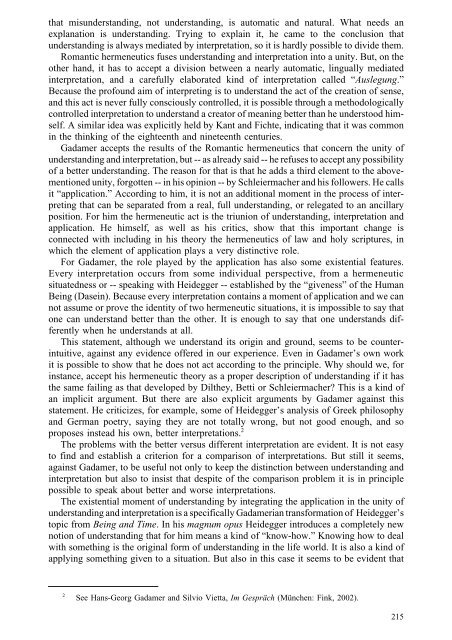[Andrzej_Wiercinski_(ed ... - WordPress.com
[Andrzej_Wiercinski_(ed ... - WordPress.com
[Andrzej_Wiercinski_(ed ... - WordPress.com
You also want an ePaper? Increase the reach of your titles
YUMPU automatically turns print PDFs into web optimized ePapers that Google loves.
that misunderstanding, not understanding, is automatic and natural. What ne<strong>ed</strong>s anexplanation is understanding. Trying to explain it, he came to the conclusion thatunderstanding is always m<strong>ed</strong>iat<strong>ed</strong> by interpretation, so it is hardly possible to divide them.Romantic hermeneutics fuses understanding and interpretation into a unity. But, on theother hand, it has to accept a division between a nearly automatic, lingually m<strong>ed</strong>iat<strong>ed</strong>interpretation, and a carefully elaborat<strong>ed</strong> kind of interpretation call<strong>ed</strong> “Auslegung.”Because the profound aim of interpreting is to understand the act of the creation of sense,and this act is never fully consciously controll<strong>ed</strong>, it is possible through a methodologicallycontroll<strong>ed</strong> interpretation to understand a creator of meaning better than he understood himself.A similar idea was explicitly held by Kant and Fichte, indicating that it was <strong>com</strong>monin the thinking of the eighteenth and nineteenth centuries.Gadamer accepts the results of the Romantic hermeneutics that concern the unity ofunderstanding and interpretation, but -- as already said -- he refuses to accept any possibilityof a better understanding. The reason for that is that he adds a third element to the abovemention<strong>ed</strong>unity, forgotten -- in his opinion -- by Schleiermacher and his followers. He callsit “application.” According to him, it is not an additional moment in the process of interpretingthat can be separat<strong>ed</strong> from a real, full understanding, or relegat<strong>ed</strong> to an ancillaryposition. For him the hermeneutic act is the triunion of understanding, interpretation andapplication. He himself, as well as his critics, show that this important change isconnect<strong>ed</strong> with including in his theory the hermeneutics of law and holy scriptures, inwhich the element of application plays a very distinctive role.For Gadamer, the role play<strong>ed</strong> by the application has also some existential features.Every interpretation occurs from some individual perspective, from a hermeneuticsituat<strong>ed</strong>ness or -- speaking with Heidegger -- establish<strong>ed</strong> by the “giveness” of the HumanBeing (Dasein). Because every interpretation contains a moment of application and we cannot assume or prove the identity of two hermeneutic situations, it is impossible to say thatone can understand better than the other. It is enough to say that one understands differentlywhen he understands at all.This statement, although we understand its origin and ground, seems to be counterintuitive,against any evidence offer<strong>ed</strong> in our experience. Even in Gadamer’s own workit is possible to show that he does not act according to the principle. Why should we, forinstance, accept his hermeneutic theory as a proper description of understanding if it hasthe same failing as that develop<strong>ed</strong> by Dilthey, Betti or Schleiermacher? This is a kind ofan implicit argument. But there are also explicit arguments by Gadamer against thisstatement. He criticizes, for example, some of Heidegger’s analysis of Greek philosophyand German poetry, saying they are not totally wrong, but not good enough, and soproposes instead his own, better interpretations. 2The problems with the better versus different interpretation are evident. It is not easyto find and establish a criterion for a <strong>com</strong>parison of interpretations. But still it seems,against Gadamer, to be useful not only to keep the distinction between understanding andinterpretation but also to insist that despite of the <strong>com</strong>parison problem it is in principlepossible to speak about better and worse interpretations.The existential moment of understanding by integrating the application in the unity ofunderstanding and interpretation is a specifically Gadamerian transformation of Heidegger’stopic from Being and Time. In his magnum opus Heidegger introduces a <strong>com</strong>pletely newnotion of understanding that for him means a kind of “know-how.” Knowing how to dealwith something is the original form of understanding in the life world. It is also a kind ofapplying something given to a situation. But also in this case it seems to be evident that2See Hans-Georg Gadamer and Silvio Vietta, Im Gespräch (München: Fink, 2002).215


